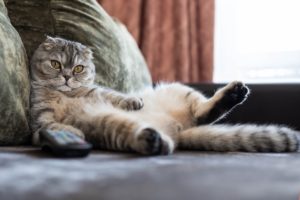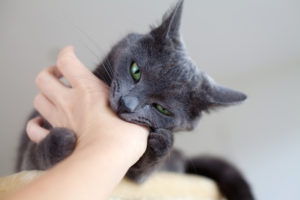Cats are known to be quick, agile, and strong hunters. In order to move so effortlessly around the room, pouncing from chair to ledge, one has to assume that their vision must be top-notch. Even in the dark, cats are known to be quite nimble (with the occasional knocking of a knickknack off a shelf).
Cats have remarkable vision, and it’s no coincidence why: They are natural-born hunters who still possess many of the same instincts as their ancestors. Their vision is essential to them, though it isn’t perfect. Keep reading to learn more about your cat’s night vision and how it came to be!
Can Cats See in the Dark?
The short answer is yes, but it’s not as superior as you might think. A lot of people think that cats are nocturnal, but that’s not exactly true either. They are actually considered crepuscular, which means they are most active at dawn and dusk. In fact, around dawn and dusk is when most cats are reported as going missing.
Cats need a small amount of light in order to see. It’s not like they have actual night vision and can see perfectly when it’s dark, but it still is better than human eyes when the sun sets. In utter, pitch-black complete darkness, they are unlikely to see very well (similar to dogs and humans), but they might have better instincts moving around in the dark than we do.
The Evolution of a Cat’s Night Vision
Cats are known to be solitary hunters, meaning that they easily rely on themselves to survive and have adapted certain instincts to make survival easier. They have vertical slit eyes that allow for more light to be let in. Plus, cats have great peripheral vision that makes hunting easier than it would be for a human in a low-light situation.
As we mentioned above, cats are more active in the early morning and evening as the sun sets. This is an opportune time for hunting, and though cats nowadays don’t need to work so hard to survive, they still have some of the same behaviors. Your cat might be more active at night or in the morning and take advantage of their ability to see better when the rest of the world is sleeping.
What Makes Cats See Better in the Dark?
While their night vision isn’t necessarily a real thing, a cat’s vision is remarkably good in any other case. They rely on their sight to help hunt, watch, and play just as much as their other senses.
Their eyes have unique aspects to them that improve their vision and help them see better through all times of the day. There is a reason that it’s hard to get by your cat without them noticing you! Thanks to their keen visual acuity, they’ve likely noticed you before you have noticed them.
How Cats See the World: The Makeup of Their Eyes
Compared to a human, a cat’s eye develops with different chemistry and functionality. For instance, a cat’s eye has completely different photoreceptors from humans. They have a high number of rods that are responsible for motion detection, peripheral vision, and night vision. Basically, their vision in the dark is as useful as their vision in the day.
This also means that in very bright light, your cat might not actually see as well because the additional rods in their eye can make what they are looking at seem overexposed.
Cats have what is called a tapetum, which is the reason for their glowing eyes in photos taken of them at night. Tapetum is a layer of tissue that reflects light back toward the retina. The reflective layer then bounces light back to sensory receptors and allows more than 50% of light into the eye.
The tapetum can come in handy for humans in a roundabout way. One way to find a missing cat is to shine a flashlight alongside the edges of the homes in your neighborhood and in nearby bushes. Hopefully, the flashlight will reveal your cat hiding, and you can bring them home.
Expandable Slit-Shaped Vertical Pupils
A cat’s eye is designed to adjust to light well and help bring more focus to the large picture. A cat’s cornea is curved, and they have a very large lens. In lower light, a cat’s pupils will expand to let more levels of light in, improving their vision as a whole.
This is why in the daytime, your cat’s eye might have a thinner slit that allows them to focus better on objects around them. They don’t need extra light as they do in the middle of the night, so it’s able to remain smaller.
Peripheral Powers
Cats are a bit near-sighted, meaning that they can’t fully focus on objects that are further away from them. However, what they lack in distance vision, they make up for in peripheral vision and the ability to see in dim light.
The field of vision for a human is about 180 degrees, but a cat’s field of vision is 200 degrees. This helps them to survey their surroundings more efficiently and keep an eye out for predators or prey.
Why Is a Cat’s Vision So Important?
Cats are used to being lone hunters, even when inside a loving home. Their instincts might tell them to hunt and to stalk, so they are going to need their vision to help them complete their journeys.
Since they are nearsighted and don’t always see things so clearly, having a wider range than human vision and the ability to function better in very low lighting helps them survive. They will feel more confident prowling around the house and stalking mice when they can make use of their eyesight.
Of course, a cat will also use their other senses to be successful, but it’s hard to ignore the power of their beautiful big eyes watching and waiting for someone to make the next move.
AskVet Has All of Your Cat Questions Covered
When we get a pet, whether it’s a dog, a cat, a hamster, or a snake, we are never prepared for all of the little questions that arise. When you sign-up for AskVet, you can gain access to Certified Pet Lifestyle Coaches™.
Schedule a session with a CPLC™, and they can help come up with cat behavior, cat exercise, and cat food plans to better your pet’s life.
With cats, it can sometimes be hard to guess what they are thinking. They are strong and independent animals who might not realize how much we need them in our lives (and in our homes). That’s why AskVet offers a free One Pet ID to help you be reunited with your cat, dog, horse, or more!
Join in with other pet parents to gush over your pet and talk about their quirks and behaviors that stick out to you when you join the Clubhouse. Don’t wait, and get involved today!
Sources:
Circular Pupil Shape Linked To Animals’ Ecological Niche | EurekAlert
Vision In Dogs And Cats | DVM 360








